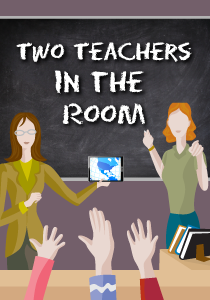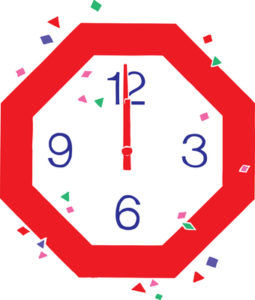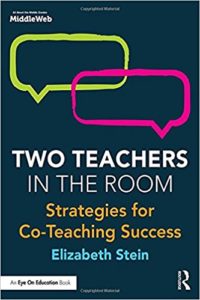Be a Better Co-Teacher in the Year to Come
A MiddleWeb Blog

Twenty-five of the 60 teachers immediately made connections to technology. Twenty of the 60 spoke of the need to guide students’ critical thinking skills. And 15 teachers shared an honest (yet sheepish) response in the category: “It’s about getting kids ready for the future—but who really knows what that looks like?”
I probed a bit deeper with this last group of 15 and asked: What do you do in your classroom to get your students ready for the future?”
Most of their responses indicated that the giving of content knowledge was a main focus for students to be ready to be successful. I needed to know more. After acknowledging the value of content knowledge, I probed a bit deeper and asked: And what does the process of learning the content knowledge look like in your classroom?
Thoughtful responses supported traditional methods (teacher-centered approaches) with an emphasis on “We just don’t have time to get creative.” Other responses: “I just have to make sure the kids get the information. There just isn’t time for anything else.” And a few made heartfelt comments like: “That is something I really have to work on.”
Looking Ahead to 2018
As a new year approaches, it seems like the perfect time to consider our view of what 21st century teaching look like. After all…it’s about time!
Think about it for a minute. Now that we are in the 21st century for almost two decades, what is your vision of what 21st century skills look like? It seems like a great question for this time of year as we make time to relax, reflect, and recharge.
And it is also about time for everyone to get on board with a consistent vision and the necessary pedagogical practices to give our students the best chance of creating their successful future.
Take Charge of Time
OK, folks! Let’s take a new perspective on what we have time for.

Let’s not waste it! Just think about how much time is wasted saying we don’t have time! In this final post of 2017, I want to share some actionable steps we can use to strengthen our 21st century teaching know-how and our vision of what is possible for the kids in our classrooms.
Ideas for 21st Century Co-Teachers
Here’s what co-teachers can do:
✻ Practice true collaboration
Meet in person to not only plan for WHAT you are teaching but HOW you are teaching. Delineate roles based on each teacher’s expertise and strengths. And don’t be afraid to step out of comfort zones. Actively listen to one another. See the classroom, the students, and yourselves from the perspective of your co-teacher. Embrace, respect, and empower one another as a part of the learning environment.
✻ Stay curious and be flexible
Stay connected with your ideas and ways of doing things – but allow your co-teacher to stretch your thinking to a new way of doing something. Find at least one way each day to acknowledge your expanding view and perspective. Accept your co-teacher’s abilities and ask yourself: How can I support his or her strengths? How can I add my thinking to my co-teacher’s?
✻ Advocate for your role
Remember your role IS all about your students. Each co-teacher must speak out to design instruction to meet the needs of every learner. Each co-teacher must be acutely aware and serve an active role in co-creating from each individual perspective. As the two teachers’ roles blend and combine, you will witness what co-teaching is all about.
✻ Vow to a Process of Life-Long Learning
We are all learners. Embrace professional learning opportunities. Be that teacher who is humble, vulnerable, and open and curious about current research, effective pedagogies, and modeling what a meaningful learning process looks like.
What Co-Teachers Can Do for Students
It’s really quite simple. Co-teachers, all you need to do is keep them engaged. Done. Enough said.
Or maybe not. I admit it’s easier said than done…how do you do that? My simplest response…just care about what your students think and feel. I mean really care about each of them as you design and deliver instruction. Accept ownership of your important, personal role in their future success.
When this caring connection is truly present, you will find that the two teachers in the room open the space to co-create a powerful learning environment with students. Here are a few essential questions to keep you on the right track:
- How are you encouraging students to be curious in your classroom?
- It’s more than having technology present – how are you using the technology is the question! How does your use of technology match with research on effective practice?
- What role does intrinsic motivation play in your learning cycles?
- What scaffolds are in place to guide your students to take initiative and to adapt within a meaningful, flexible cycle of learning?
- Do students feel comfortable to take risks? To make mistakes AND self-correct with the power of humility?
- What instructional methodologies do you embed to support students’ effective oral and written communications?
- Are you co-creating paths of critical thinking? Do students experience the thrills and the challenge of thinking that pushes them beyond their current personal thinking spaces?
I would love to hear from you! Add your voice to the 60 teachers I mentioned earlier. Answer any one of the 7 questions above—or simply share your reflections as 2017 comes to a close…Are you a 21st Century teacher? And even more to the point…Are you a 21st Century co-teacher?
Let’s make 2018 the year we can each say, YES! I am a 21st Century Teacher!








































Great article. This definitely jump started my Co teaching “practice”. Especially the idea of meeting to talk not only about what is being taught, but how.
To answer your question number 4, Co teaching in the math class really helps us provide lots of scaffolded worksheets, activities, stations, etc. It’s a lot to ask a given teacher to do all these things, but the co teaching situation can really help differentiate the day to day.
Hi, Beckett. It’s easy to feel the spark to your jump start–thanks for sharing! So true, math has endless possibilities for expanding options in the learning process–and with two teachers in the room–well, it’s double the power!
Please consider joining our Twitter #CoTeachat this Tuesday, 1/9 at 8:00 ET when we will continue these conversations in real time using the hashtag.
And of course, this comment section continues to be open for conversations–many thanks!
Enjoy!
Elizabeth
Unfortunately I missed the chat. How often do you have it?
Beckett, #CoTeachat is every 2nd and 4th Tuesday each month…at 8:00 ET. And the hashtag, #CoTeachat is hopping 24/7! See you on Twitter! :)
Sounds great. Thanks!
HI Elizabeth- I’m doing my master’s thesis on co-teaching. I’m interested in the 60 people you surveyed. I’m looking for teacher feedback from those who are actively co-teaching. Do you have an email I could contact you at? Thank you!!!
Hi, Liz, Great to hear about your focus for your thesis! Thank you for reaching out–I would love to connect with you. You may reach me at estein.educator@gmail.com
Hello Elizabeth,
This is Dr. Pete Post of Trinity Christian College and also an OLD fan. I am currently teaching a masters level course on educating students with low incidence disabilities to a group of six wonderful teachers that are seeking to increase their own abilities despite managing busy lives of their own. I definitely wanted them to take a look at your blog at Two Teachers in the Room to discover some of your own thoughts and challenges on becoming the best teacher one can be. I am asking each of them to respond to your request to provide an answer to one of your essential questions and to peruse your other blog entries as well. Thank you for your own dedicated efforts towards making classrooms for all students (and perhaps two teachers) a functioning reality.
Hello, Dr. Pete Post! It is great to connect again. Thank you for your response…and also for staying the course with me as we all work together to make co-teaching a meaningful experience for everyone involved. I look forward to hearing your students’ insights!
I am one of Professor Post’s students, and I find your seventh question particularly interesting. I am in second and third grade classrooms during language activities, where we try to incorporate critical thinking by linking the language activity to math, science, social studies, and even art. Connecting these subjects is sometimes a difficult task to accomplish, but with some creativity you can get the students to see how unrelated things can come together. Recently while working on a reading passage on leap day, we connected to math by figuring out why we need an extra day every four years, connected to science by talking about whether other planets need to have leap days, and asking the students to tell us if they would like to have their birthday on leap day and explain why. Developing not only the ability to think critically, but to communicate those thoughts effectively is something we try to do. To me the ability to think critically is one of the most important skills to teach students because it is a necessary skill across all academic subjects.
I am a student in Professor Post’s class. I co-teach first grade. I am the general education teacher. I feel I’m always letting my students be curious in the classroom. I want the students come up with their own answer and not rely on me for all the answers. At time they may ask me questions about animals and I might not even know the answer! I have them get their chromebook out and have them find the answer. I let the students make their own discoveries with some guidance. If they have questions I have them answer their own questions first and help them discover the answer, sometimes there may be more than one answer. I incorporate STEM projects in the curriculum and that has sparked more curiosity amongst young children over the past couple of years. The love of learning comes from being curious and seeking out information and want to learning more. There needs to be more curious learners out there we need to promote the curiosity.
Yes, great to hear the ways you spark curiosity–you mention such meaningful ideas! Great to hear about your interest with the natural STEM connection. You should also check out Anne Jolly’s blog right here at MiddleWeb: STEM by Design https://www.middleweb.com/category/stem-by-design/
I am one of Professor Post’s students. I am an elementary physical education teacher. I thought question one was interesting. In p.e. my students are always curious to learn new activities, exercises, or sports. My school is mainly low income so exposing my students to new ways of being active it my main goal. During class, I often give my students a chance to do their own exercise. This shows them there are other ways of getting their heart rate up. So many of my students come up to me and tell me that they bring these exercises or activities home and show their family. This lets me know I was successful!
What a great article!! I loved your comment regarding time. I agree with you 100% that it is a disservice to the students we teach to use that as an excuse for intructional practices lacking. As teachers, we went into this profession knowing how much time would go into teaching and prepping materials for our students. I am a special education teacher that luckily gets to work with a SLP as a co-teacher in my classroom. I also agreed with your section on collaboration. It has made such a difference in my own teaching being able to collaborate with someone else. Practicing collaboration and having an open communication system in place will help to make for a successful classroom. Instead of having a mentality that what we are doing in our classrooms is the only way or the right way, we need to keep an open mind to trying new things. I’m will continue to and look forward to collaborating further this year with colleagues to improve my perfomance for my students.
I really enjoy the content of your blog! In years past I had the opportunity to co-teach with one of our special ed teachers. Her techniques were awesome and I learned a great deal from her and, as it turns out, she from me. I teach Kindergarten and she hadn’t had much experience with kindergarten so we worked very well off of each other. I have to say those were some of my best teaching years. It is so nice to collaborate so closely with another teacher. In question number 5, you ask if students feel comfortable taking risks and self correct with humility. In my classroom they see me make mistakes quite frequently. I am very open with them when I make a mistake and I definitely let them watch how I fix my mistakes. I make sure I apologize if the mistake I made effected any one individual and they learn from that model. I let them know I am not perfect and it is ok to make mistakes because we can’t learn if we don’t make mistakes. I also like to have students explain other student’s work (anonymously) on doc cameras so they can see different techniques in correcting mistakes. I let them know that sometimes mistakes can even be fun.
I really enjoyed reading your article. Your breakdown of co-teaching was truly appreciated. We have co-teaching at the high school that I work at, but often times I hear a lot of special education teachers complain. It seems that they are either pushed to the side and are not utilized, or the general education teacher is over-utilizing them, and not completing his/her half of the work. Co-teaching can be so beneficial, but teachers must collaborate, and discuss their roles together. I also think administration needs to remind both teachers of their expectations. Furthermore, I really like question #2. All of our students now have a one-on-one device for school. A lot of teachers are incorporating the devices in their classrooms, however, it seems as if some of them are using it just to use it, rather than thinking about how the lesson can be enhanced now that their is technology available. Having students complete a worksheet on canvas saves paper, but continuously doing that does not enhance what the students are learning, or contribute to student engagement.
Hello, everyone! Thank you for reading and making the time to share your insights and experiences. Your collective voice brings forth many great examples examples to highlight the importance of embedding critical thinking through multiple resources. Hope to connect again soon!
I was talking to my friend the other day about her interest in learning more effective teaching methods. She wants to make sure that she is inspiring an environment for students to learn and grow. It might help her to ask herself if she is creating paths of critical thinking for her students.